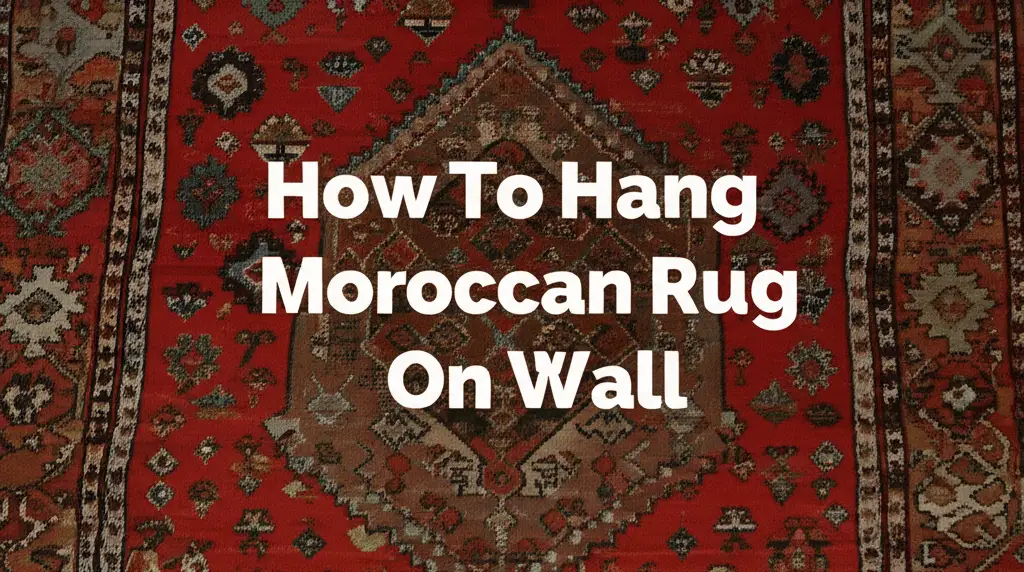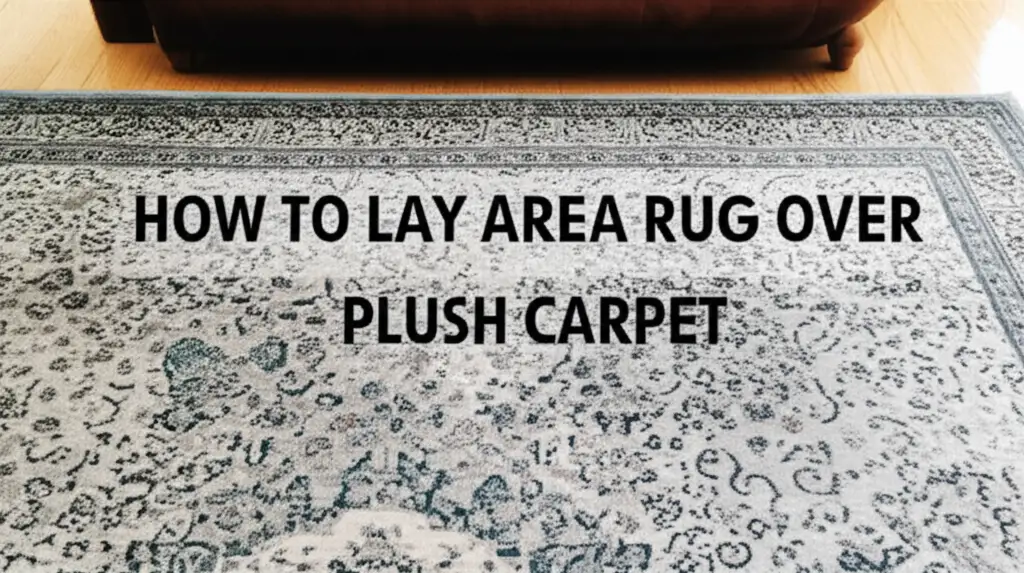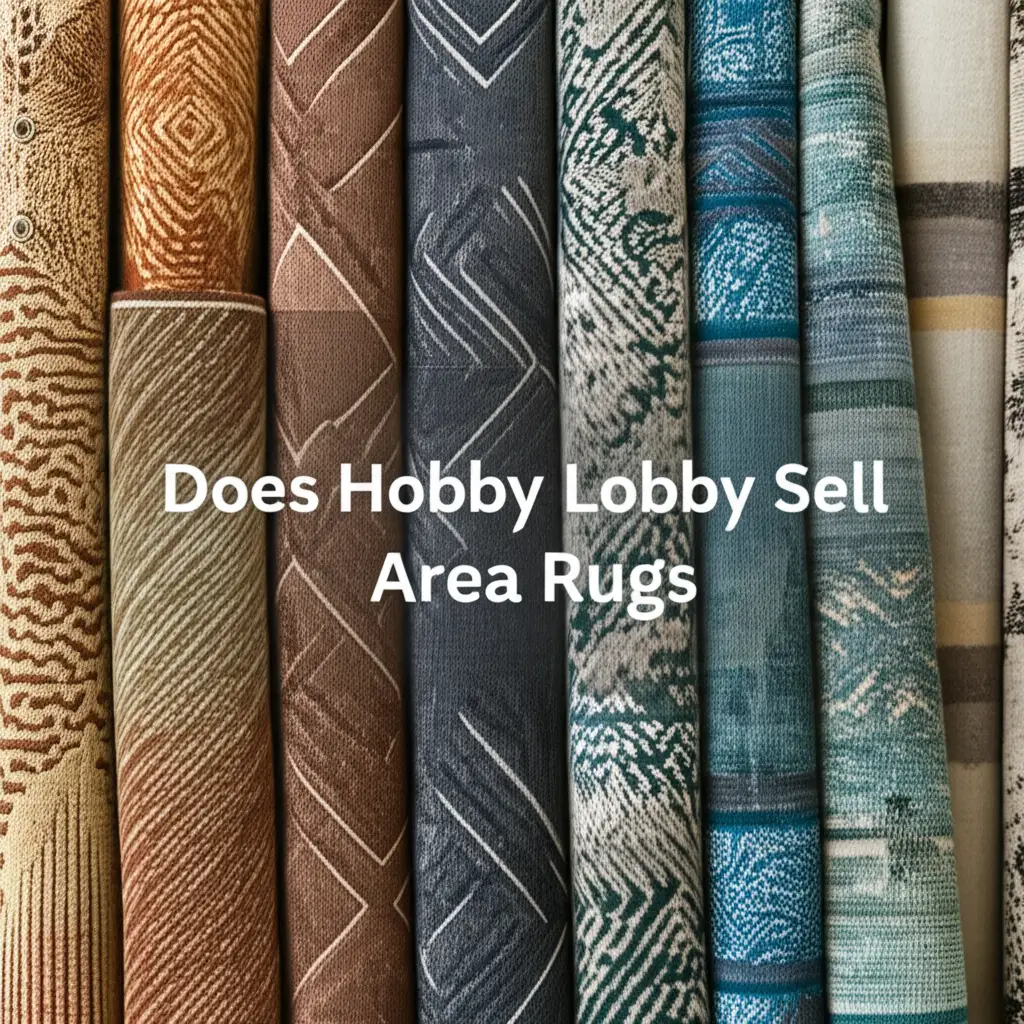· Tessa Winslow · Home Decor · 19 min read
How To Hang Moroccan Rug On Wall

How To Hang Moroccan Rug On Wall
Do you own a stunning Moroccan rug? These beautiful textiles are more than just floor coverings. They are true art pieces, full of history and culture. Many people want to display their Moroccan rug on a wall. It adds warmth, texture, and a unique focal point to any room. Learning how to hang a Moroccan rug on wall protects your investment. Proper hanging ensures the rug’s beauty lasts for many years. This guide explores the best methods to display your cherished textile safely. We will cover preparation, different hanging options, and care tips.
Takeaway
Hanging a Moroccan rug on a wall can transform your space. Use methods that support the rug’s full weight evenly. Avoid damage to the fibers.
- Choose a method like a fabric sleeve, rug clips, or Velcro for proper support.
- Measure your rug and the wall space carefully before you begin.
- Clean the rug before hanging to prevent dust buildup.
- Protect the rug from direct sunlight and pests.
A Moroccan rug on the wall becomes a beautiful piece of art.
To hang a Moroccan rug on a wall, use methods that spread the rug’s weight evenly. A fabric sleeve sewn to the back is often the best choice for heavier rugs. For lighter pieces, rug clips or strips of Velcro can work well. Always ensure the wall anchors are strong enough to hold the rug securely without causing damage.
Understanding Your Moroccan Rug Before Hanging
Moroccan rugs are unique. They come in many sizes, weights, and materials. Knowing your specific rug helps you choose the best hanging method. These rugs often feature intricate designs and vibrant colors. They are typically hand-knotted from wool. Wool is a strong fiber, but it can stretch or distort if not supported correctly.
Consider your rug’s age. Older, vintage Moroccan rugs may be more fragile. They need extra care during handling and hanging. A heavy rug requires stronger support than a lighter one. Look at the rug’s weave. Some rugs have a tight, dense pile. Others might be more loosely woven. Each type needs specific hanging consideration. I always check for any existing damage before I plan to hang it. A small tear could worsen with improper support.
Material and Construction
Most Moroccan rugs use 100% natural wool. This makes them durable, but also heavy. Hand-knotted construction means each knot is tied individually. This creates a strong, lasting textile. The wool fibers absorb moisture. They can also attract dust over time. This is why cleaning before hanging is important. You want your rug to be in the best condition. If you have a wool rug, you might also be interested in how to clean a handwoven wool rug.
Value and Authenticity
Moroccan rugs can be valuable. Their worth depends on age, origin, size, and design. Many are cultural artifacts. Ensuring you hang your rug correctly protects its value. Improper methods can cause permanent damage. A true Moroccan rug is an investment. You can learn more about how much are Moroccan rugs in Morocco. This information can help you understand the potential value of your piece. Treating it with care preserves its beauty and history.
Choosing The Right Location For Wall Display
Selecting the perfect spot for your Moroccan rug is important. The right location enhances its beauty. It also helps preserve the rug over time. Think about the room’s layout. Consider the amount of natural light. Wall space and existing decor also play a role. I always look for a wall that allows the rug to be a focal point.
Avoid direct sunlight. Sunlight can fade colors over time. This is especially true for natural dyes often found in Moroccan rugs. A wall that gets some indirect light is fine. But a spot where the sun shines directly on the rug for hours each day is not ideal. Fading can diminish the rug’s appearance. It can also reduce its overall value.
Consider the wall’s material. Drywall, plaster, or concrete each need different fasteners. A secure hanging method depends on the wall type. Make sure the wall is strong enough to support the rug’s weight. Heavy rugs need solid anchoring points. You do not want the rug to fall or pull away from the wall.
Lighting Conditions
Natural light is wonderful. It brings out the rug’s colors. But too much direct sun causes harm. If you must hang it in a sunny room, use UV-filtering window treatments. These help protect the fibers. Artificial lighting is also important. Spotlights can highlight the rug’s textures. Ensure lights do not generate too much heat. Heat can also damage fibers over time.
Room Aesthetics and Balance
Your Moroccan rug is a piece of art. It should complement the room’s design. Think about scale. A large rug needs a large wall. A small rug can fit in smaller spaces. Consider the colors in your room. Moroccan rugs come in a wide range of hues. Choose a spot where the rug’s colors harmonize with your furniture. The rug should balance the room. It should not overwhelm it. It should become a beautiful part of your home story.
Preparing Your Moroccan Rug for Wall Display
Before you hang your beautiful Moroccan rug, preparation is key. Proper steps ensure the rug is clean and ready. This also helps prevent future damage. I always start with a thorough inspection of the rug. Look for any loose threads or signs of wear. Address these issues before hanging. Small repairs now can save big problems later.
Cleaning your rug is a must. Even if it looks clean, dust and dirt can settle deep in the fibers. Wall hanging exposes the rug to less foot traffic. However, dust can still accumulate. A clean rug looks its best. It also helps prevent insect damage. Moths are attracted to dirty fibers.
Measuring the rug is also important. You need accurate dimensions to plan your hanging method. Measure the length and width. Note any irregularities in shape. Moroccan rugs are often handmade. They may not be perfectly symmetrical. Account for these unique characteristics. Knowing the exact size helps you choose the right hanging hardware. For more information, you might want to learn how to know rug size.
Cleaning Your Rug
Start by gently vacuuming both sides of the rug. Use a low suction setting. Be gentle to avoid damaging the fibers. If the rug needs deeper cleaning, consider professional help. For general cleaning, a soft brush can remove surface dust. You can also carefully spot clean any visible marks. Always test cleaning solutions in a small, hidden area first. This prevents discoloration. Knowing how to clean a rug by hand is a useful skill. For wool rugs, specific care is necessary. For example, learning how do you clean an area wool rug provides good guidelines.
Inspecting for Damage
Carefully inspect the rug’s edges and fringe. Look for loose knots or frayed areas. If you find small issues, mend them. A local rug repair specialist can help with larger problems. Check for any signs of moth activity. Small holes or a powdery residue are indicators. If you find pests, treat the rug before hanging. Proper treatment protects your rug from further harm. This step ensures your rug remains beautiful for years.
Popular Methods for Hanging Moroccan Rugs
Several methods exist for hanging Moroccan rugs. Each method has its pros and cons. The best choice depends on the rug’s size, weight, and your desired display. My goal is always to choose a method that offers maximum support. This protects the rug from stress and damage. Even weight distribution is key.
One common and highly recommended method is the fabric sleeve. This involves sewing a strong fabric sleeve to the back top edge of the rug. A rod then slides through this sleeve. The rod hangs on wall brackets. This method provides excellent, even support. It prevents the rug from sagging. It also avoids placing stress on individual fibers.
Another option is using rug clips or clamps. These clips grip the top edge of the rug. They then hang from hooks on the wall. This method is simpler to install. It works well for lighter rugs. However, heavy rugs can experience strain where the clips grip. This can cause dimpling or damage over time.
Velcro is another possibility. One strip of Velcro is sewn to the rug’s top edge. The matching strip is attached to a wooden batten. The batten is then secured to the wall. This offers good support. It is less visible than clips. However, sewing Velcro to the rug requires careful stitching. The adhesive on the wall strip must be strong. It needs to hold the rug’s weight.
Fabric Sleeve Method
The fabric sleeve is often considered the gold standard. It provides continuous support along the entire top edge. You sew a wide, strong cotton or linen sleeve to the back of the rug. Make sure the sleeve is a few inches wide. This allows for a sturdy rod to pass through. The rod should be strong metal or wood. It needs to extend beyond the rug’s width. This allows it to rest on wall brackets. This method ensures no single point bears the rug’s weight. It prevents sagging and stretching.
Rug Clips or Clamps
Rug clips are a quick solution. They look like large bulldog clips. You attach them to the top edge of the rug. Then, you hang the clips from screws or hooks on the wall. Use many clips for wider rugs. Space them evenly. This helps distribute the weight. This method is best for small, lightweight rugs. For heavier Moroccan rugs, the clips can pinch the fibers. This creates creases. It might also cause tears over time.
Velcro Hanging System
A Velcro system involves two parts. One part is the soft loop side of the Velcro. You sew this directly onto the top back edge of the rug. The other part is the hook side of the Velcro. You attach this to a wooden strip or batten. The batten is then mounted to the wall. Ensure the batten is level. Use screws that go into wall studs. This method offers a clean, hidden look. It provides strong, continuous support. Make sure the Velcro is wide enough for the rug’s weight. A strong bond is essential.
Step-by-Step Guide: The Fabric Sleeve Method
The fabric sleeve method is widely recommended for hanging Moroccan rugs. It is secure. It protects the rug from damage. I prefer this method for its reliability and gentle support. It distributes the rug’s weight evenly. This prevents sagging or stress on specific fibers. This section will guide you through each step.
You need a few materials. Get a sturdy fabric, like cotton duck or heavy linen. The fabric should be wider than your rug. You also need a strong wooden or metal rod. The rod should be slightly longer than your rug’s width. Wall brackets are also necessary. Choose brackets that match your rod’s size. Finally, gather sewing supplies. You will need a strong needle and thread.
Step 1: Prepare the Fabric Sleeve
Cut a strip of fabric. It should be twice the desired width of your finished sleeve, plus seam allowances. A sleeve width of 3-4 inches is common for most rugs. So, cut a strip 7-9 inches wide. The fabric strip should be as long as your rug’s width, plus a few inches on each end. Fold the fabric strip in half lengthwise, wrong sides together. Press the fold. This creates a neat top edge for your sleeve.
Step 2: Attach the Sleeve to the Rug
Position the folded fabric strip along the top back edge of your rug. The raw edges of the fabric should align with the raw edge of the rug. Pin the fabric sleeve in place. Use many pins to hold it securely. Ensure the sleeve is perfectly straight. Hand-sew the sleeve to the rug. Use a strong needle and a durable thread. Stitch through the rug’s backing, not through the pile. Make small, even stitches. Sew along both the top and bottom edges of the folded sleeve. This creates a channel for the rod.
Step 3: Mount Wall Brackets
Decide where you want to hang the rug. Use a level to mark the exact spots for your wall brackets. The brackets must be wide enough to support the rod. Ensure the distance between brackets is slightly less than the rod’s length. Use appropriate wall anchors. If hanging on drywall, use drywall anchors. For studs, use wood screws. Make sure the brackets are firmly attached. They must hold the rug’s total weight. This step is critical for safety.
Step 4: Insert the Rod and Hang the Rug
Slide your chosen rod through the fabric sleeve you sewn onto the rug. Make sure the rod is centered within the sleeve. Lift the rug and rod together. Carefully place the ends of the rod onto the mounted wall brackets. Adjust the rug until it hangs straight and evenly. Step back and admire your beautifully displayed Moroccan rug. The fabric sleeve method ensures your rug hangs securely. It protects your valuable textile for many years.
Alternative Hanging Solutions and Considerations
While the fabric sleeve is ideal, other methods exist. These alternatives might be suitable for specific rugs or situations. Always prioritize the rug’s preservation. Never use methods that can damage the fibers or structure. The goal is a display that lasts.
Some people consider using a simple wooden dowel and clamps. The dowel is strong. The clamps grip the rug. This works for very small, light rugs. However, the pressure from clamps can distort the rug’s weave. This is not ideal for larger or heavier Moroccan rugs. Remember, uneven stress points can lead to lasting damage.
Another option is custom framing. This is usually for very small, delicate, or exceptionally valuable textile pieces. The rug is mounted onto a board. It is then enclosed in a protective frame. This offers maximum protection from dust and physical damage. However, it is an expensive solution. It also limits interaction with the rug.
For temporary displays, simple tapestry hangers might work. These often have small teeth that grip the fabric. They are easy to install and remove. But they offer minimal support. They can also snag fibers. I would not recommend these for long-term display of a cherished Moroccan rug. These methods are best for very light, non-valuable textiles.
Velcro System Refined
The Velcro method is a good alternative to the sleeve. As mentioned before, sew the soft loop side of the Velcro onto the rug’s back. Use a wide, strong Velcro strip. Ensure your stitches are secure. For the wall side, use a wooden batten. Attach the hook side of the Velcro to this batten. Then, screw the batten into wall studs if possible. If not, use heavy-duty drywall anchors. This system offers a clean, invisible hang. It distributes weight well if the Velcro is wide and strong enough.
Batten and Strip Method
This method is similar to Velcro, but without the hook-and-loop closure. You sew a strip of fabric to the back of the rug. This fabric strip has small loops or grommets. A wooden batten is then mounted to the wall. Small nails or hooks on the batten engage with the loops on the rug. This method is less common. It requires precise measurements for the loops. It provides good support, but installation can be tricky. Ensure the nails or hooks are smooth. They must not snag the fabric loops.
Protecting Your Rug During Hanging
Regardless of the method, always handle your rug with care. Avoid pulling or tugging on the fibers. When moving the rug, support it from underneath. Do not drag it. Wear clean gloves if possible. This prevents transfer of oils from your hands. Consider the weight. Get help if the rug is too heavy to lift alone. A second person helps ensure the rug hangs straight. Proper care during installation extends the life of your beautiful rug.
Maintaining Your Wall-Hung Moroccan Rug
Hanging your Moroccan rug on the wall is a great way to display it. But the work does not stop there. Proper maintenance is vital. It keeps your rug looking fresh and vibrant. It also protects it from damage over time. My own rugs always get regular attention. A little care goes a long way.
Dust is the enemy of any textile. Even on a wall, dust can settle on your rug. Regular, gentle dusting helps. Use a soft brush or a low-suction vacuum. Be very gentle when cleaning. You do not want to pull on the fibers. Avoid harsh chemicals. They can damage the natural wool.
Sunlight, as mentioned before, causes fading. Even indirect light can slowly alter colors. If your rug is in a sunny room, consider window treatments. UV-filtering blinds or curtains are a good choice. They protect your rug without blocking all light. Rotate the rug every few years if possible. This helps ensure even exposure to light.
Pests are another concern. Moths love natural fibers like wool. Inspect your rug periodically for signs of insect activity. Small holes, web-like material, or tiny larvae are red flags. Keep the area around the rug clean. Consider using natural moth repellents like cedar. Proper storage conditions are also important if you ever take the rug down.
Gentle Cleaning
Once your rug is on the wall, cleaning becomes simpler. Use a soft-bristled brush. Gently brush the surface to remove dust. You can also use a vacuum cleaner with a soft upholstery attachment. Set the vacuum to its lowest suction. Move it slowly over the rug. Do not use beater bars. They can damage delicate fibers. For any spills, address them immediately. Blot the area with a clean cloth. Use only water or a very mild wool-safe cleaner. Do not rub the stain.
Environmental Protection
Control the humidity in the room. High humidity can encourage mold or mildew growth. Low humidity can make fibers brittle. A consistent, moderate humidity level is best. Use a humidifier or dehumidifier as needed. Keep the rug away from heat sources like radiators. Heat can dry out and damage fibers. Ensure proper air circulation around the rug.
Pest Control and Inspection
Regularly check the back of your rug. Look for any signs of moths or other insects. Pay attention to corners and areas near the wall. These are common hiding spots. If you suspect pests, consult a professional rug cleaner or conservator. They can advise on safe treatment options. You can place cedar blocks or lavender sachets nearby. These natural deterrents are safe for your rug. Protecting your rug from pests extends its life. It preserves its beauty for future generations.
Displaying Your Moroccan Rug as Art
Hanging a Moroccan rug on your wall turns it into a magnificent piece of art. It creates a focal point. It adds warmth and character to any room. These rugs are more than just functional items. They are expressions of culture and tradition. Each knot tells a story. When you display your rug, you are celebrating its unique journey.
Think about how the rug fits into your existing decor. A vibrant Beni Ourain can brighten a minimalist space. A richly patterned Kilim can add bohemian flair. The rug’s textures, colors, and patterns interact with your furniture. They create a harmonious environment. I love how a well-placed rug transforms a simple wall into a gallery.
Consider the other elements in the room. Wall art, plants, or shelving should complement the rug. Avoid cluttering the space around it. Let the rug stand out. Give it room to breathe. The beauty of a Moroccan rug lies in its intricate details. You want people to appreciate these details.
Enhancing Your Interior Design
A Moroccan rug on the wall instantly elevates a room’s style. It adds a touch of global elegance. It brings a story into your home. The rich history behind each rug makes it more than just decoration. It is a conversation starter. It reflects your personal taste. You are bringing a piece of heritage into your daily life.
Pairing with Other Decor
To make your rug shine, pair it with complementary pieces. For example, simple furniture allows the rug to be the star. Earthy tones in your decor can highlight the rug’s natural dyes. Consider adding plants. Greenery complements the organic feel of wool rugs. You can also layer other textile art pieces. But make sure they do not compete with the rug. The goal is to create a cohesive and inviting space. Let your Moroccan rug be the heart of your wall display.
FAQ Section
Can any Moroccan rug be hung on a wall?
Most Moroccan rugs can be hung on a wall. Consider the rug’s weight and fragility. Very large or heavy rugs need strong, professional hanging systems. Smaller, lighter rugs offer more flexibility. Always prioritize methods that distribute weight evenly. This prevents damage to the fibers and structure.
How do I clean a wall-hung Moroccan rug?
Gently dust your wall-hung Moroccan rug regularly. Use a soft brush or a low-suction vacuum cleaner with an upholstery attachment. Avoid harsh chemicals or excessive moisture. If you notice any spills or stains, blot them immediately with a clean, damp cloth. For deep cleaning, consult a professional rug cleaner.
Will hanging a rug damage my wall?
Properly installed wall anchors and brackets will support the rug. This avoids damage to your wall. Use anchors appropriate for your wall material (drywall, plaster, concrete). Ensure the rug’s weight is calculated. This helps choose the correct fasteners. Improper installation can cause holes or stress cracks in the wall.
How can I protect my wall-hung rug from fading?
Protect your wall-hung Moroccan rug from direct sunlight. UV rays can cause the colors to fade over time. Use UV-filtering window films or curtains in sunny rooms. You can also rotate the rug every few years. This ensures even light exposure. Keep the rug away from heat sources like radiators.
How do I prevent pests from damaging my wall-hung rug?
Regularly inspect your wall-hung rug for signs of moths or other pests. Clean the rug often to remove dust and debris. This reduces pest attraction. You can use natural repellents like cedar blocks or lavender sachets near the rug. If you find signs of pests, consult a professional for treatment options.
Conclusion
Learning how to hang a Moroccan rug on wall transforms a beautiful floor covering into a captivating piece of textile art. We have explored the best methods to ensure your cherished rug is displayed safely and securely. From understanding your rug’s unique characteristics to selecting the right location, each step helps preserve its beauty. Using methods like the fabric sleeve provides even support. This protects the rug from damage.
By preparing your rug with proper cleaning and inspection, you extend its life. Choosing the ideal spot in your home ensures the rug becomes a stunning focal point. Regular, gentle maintenance keeps your wall-hung Moroccan rug vibrant for many years. It prevents dust, fading, and pest damage. Hanging your Moroccan rug is more than just decorating. It is about celebrating culture and craftsmanship. I encourage you to choose the method that best suits your rug and your home. Make your Moroccan rug a centerpiece that inspires and delights. Take action today and give your rug the wall display it deserves!





